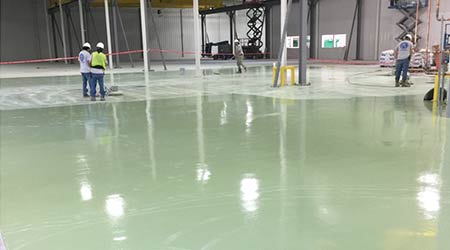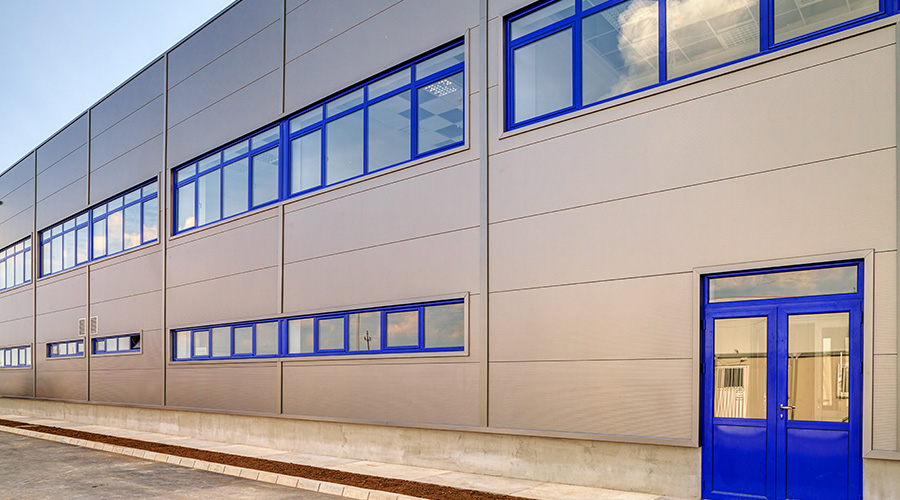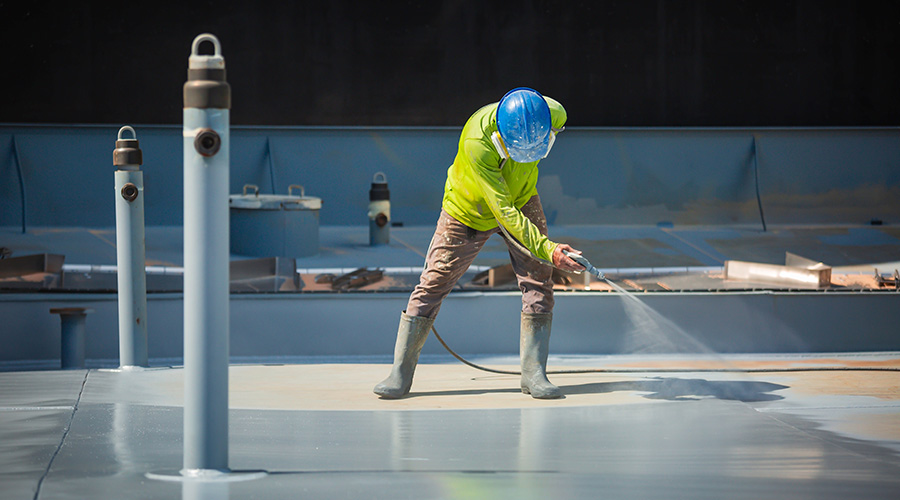 Slip-resistant coating is installed over existing concrete.
Slip-resistant coating is installed over existing concrete. Slip-Resistant Coatings: Basics for Facility Managers
The installation process can affect the performance of slip-resistant coatings.
Today, there is a wide range of specialty paints and coatings designed to address a multitude of needs in and around commercial and institutional facilities. Facility managers should understand that each coating has its own personality. There is no panacea for all coating situations. To select the best paint or coating product for a given application can be challenging for facility managers. Facility managers should have a basic understanding of the following common types of specialty paints and coatings: slip-resistant, anti-corrosive, anti-graffiti, reflective, dry erase, and chalkboard.
Regardless of the type coating needed, always match the correct product to the intended purpose by referring to and complying with manufacturer's product data sheets during selection, evaluation, and application.
Basics of slip-resistance
Because of their importance to safety and the potential for personal injury litigation, slip-resistant coatings will be discussed first. These coatings are intended to prevent accidental falls when applied over walking surfaces. These coatings are usually applied over concrete, but can also be applied over metal and wood.
Since slip-resistance is referenced in the International Building Code (IBC 2012), a brief discussion on its origin is in order. Slip-resistance values are based on the static coefficient of friction (SCOF) and dynamic coefficient of friction (DCOF) of the walking surface. Coefficient of friction is the ratio of the force required to put an object in motion (slide/slipping) and the weight of that object. If the sliding begins when that object is stationary (at rest), the resistance to sliding is SCOF. If sliding begins when that object is already in motion (walking etc.), that resistance is DCOF.
International Building Code IBC 2012 references slip resistance via ANSI A137.1. However, this reference applies to ceramic tile and that is probably because the Tile Council of North America (TCNA) was very influential in developing that standard. Even though that reference refers to ceramic tile, both SCOF and DCOF apply to most surfaces. Thus, it can be presumed that if the same instruments and methods are used for measuring, a SCOF of .42 means the same resistance value, whether measured on a tile, epoxy, polished concrete, or other walking surfaces.
Some floor-covering manufacturers reference Americans with Disabilities Act guidelines for slip resistance. However, ADA did not set a requirement, but instead referenced accessibility guidelines that recommended a SCOF value under wet conditions of .60 for level surfaces and .80 for ramps. According to TCNA, this reference did not specify test equipment or method. There are various instruments available to measure COF, and those instruments may not use the same method of measuring and may produce different test results that vary from those recommended, such as the .60 SCOF.
References 9 and 10 at the end of this article offer more detailed discussions of slip resistance and its testing standards and testing equipment.
Understanding slip-resistant coatings
Slip-resistant coatings are marketed by many trade sales coating manufacturers as well as by specialty coating manufacturers. When selecting a slip-resistant coating, it is imperative to evaluate the conditions where the coating will be used. These conditions include exterior, interior, exposure to wetting or to oils, cleaning methods (frequency, equipment, cleaning materials), type and frequency of traffic the floor is exposed to (running, walking, pushing objects), and the condition of pedestrians (elderly, people with disabilities, children, etc.). Slip-resistant coatings can be a convenient and economical method to achieve slip resistance; however, the slip-resistance values of the same coating can vary from one installation to another depending on installers and application methods. This suggests that installed slip-resistance values may deviate from advertised values.
Slip-resistant coatings can be produced in various generics, with epoxy probably being most common. A coating's slip resistance can be obtained by an orange-peel-type finish that is achieved by the method of application or by an aggregate embedded in the finish coating. The aggregate in the coating can be factory-embedded at the time of manufacture or it can be field-embedded just prior to application.
When selecting a coating, review the manufacturer's product data sheets to determine the slip-resistance value and the standards used to achieve that value. When a manufacturer lists a COF value, that is the value that was obtained by the manufacturer during its testing. After a product is selected, a mock-up of the product should be installed on the substrate to be coated and tested according to the required standards. A manufacturer's tested and advertised COF may be code-compliant, but for slip-resistant products where the aggregate is added to the coating during installation, the installation methods and conditions may cause different COF values. Therefore, COF testing should be conducted after installation and prior to owner acceptance. Also, as a precaution, the coating should be tested regularly, especially if it is exposed to heavy traffic, frequent cleaning, grease, food spills, etc.
Related Topics:















